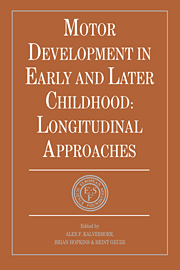Book contents
- Frontmatter
- Contents
- List of contributors
- Foreword
- Preface
- SETTING THE SCENE
- SECTION I BIOLOGICAL BASIS OF MOTOR DEVELOPMENT
- SECTION II DEVELOPMENT OF BODY POSTURE AND GOAL-DIRECTED REACHING
- SECTION III MOTOR DEVELOPMENT, EARLY COMMUNICATION AND COGNITION
- 9 Early interactional signalling: the role of facial movements
- 10 Motor development: communication and cognition
- 11 On faces and hands and the development of communication
- SECTION IV ACQUISITION OF SKILLS
- SECTION V MOTOR DEVELOPMENT AND HANDICAP
- SECTION VI METHODOLOGICAL AND CONCEPTUAL CONSIDERATIONS
- Epilogue: description versus explanation
- Index
10 - Motor development: communication and cognition
from SECTION III - MOTOR DEVELOPMENT, EARLY COMMUNICATION AND COGNITION
Published online by Cambridge University Press: 05 May 2010
- Frontmatter
- Contents
- List of contributors
- Foreword
- Preface
- SETTING THE SCENE
- SECTION I BIOLOGICAL BASIS OF MOTOR DEVELOPMENT
- SECTION II DEVELOPMENT OF BODY POSTURE AND GOAL-DIRECTED REACHING
- SECTION III MOTOR DEVELOPMENT, EARLY COMMUNICATION AND COGNITION
- 9 Early interactional signalling: the role of facial movements
- 10 Motor development: communication and cognition
- 11 On faces and hands and the development of communication
- SECTION IV ACQUISITION OF SKILLS
- SECTION V MOTOR DEVELOPMENT AND HANDICAP
- SECTION VI METHODOLOGICAL AND CONCEPTUAL CONSIDERATIONS
- Epilogue: description versus explanation
- Index
Summary
INTRODUCTION
This chapter considers briefly the main relationships between some rather common motor behaviours, namely how babies point things out for others, how they look where someone else is pointing and whether these communicative acts may be based on how babies know to look where someone else is looking. Although theories abound, most empirical research on these topics is relatively recent and not a great deal has been carried out longitudinally. Longitudinal work, where it has-occurred, and some issues which may be suitable for longitudinal study are be mentioned.
The communicative functions of visual attention are widely recognized. For example, gaze monitoring is thought to be important in governing social interaction in the higher primates (Whiten & Byrne, 1988). In human development monitoring gaze is thought to pave the way for deictic gestures, such as manual pointing, which draw attention to a particular object by locating it for another person (Bruner, 1983). Joint visual attention, simply expressed as ‘looking where someone else is looking’, is known technically as ‘deictic gaze’. Joint attention implies communication in relation to a shared focus of attention; it provides one possible basis in shared experience for the acquisition of language (Bruner, 1983). This chapter first considers theories explaining the origins of manual pointing, then empirical research is discussed which may describe pointing in relation to processes of joint visual attention.
- Type
- Chapter
- Information
- Motor Development in Early and Later ChildhoodLongitudinal Approaches, pp. 153 - 165Publisher: Cambridge University PressPrint publication year: 1993
- 3
- Cited by

